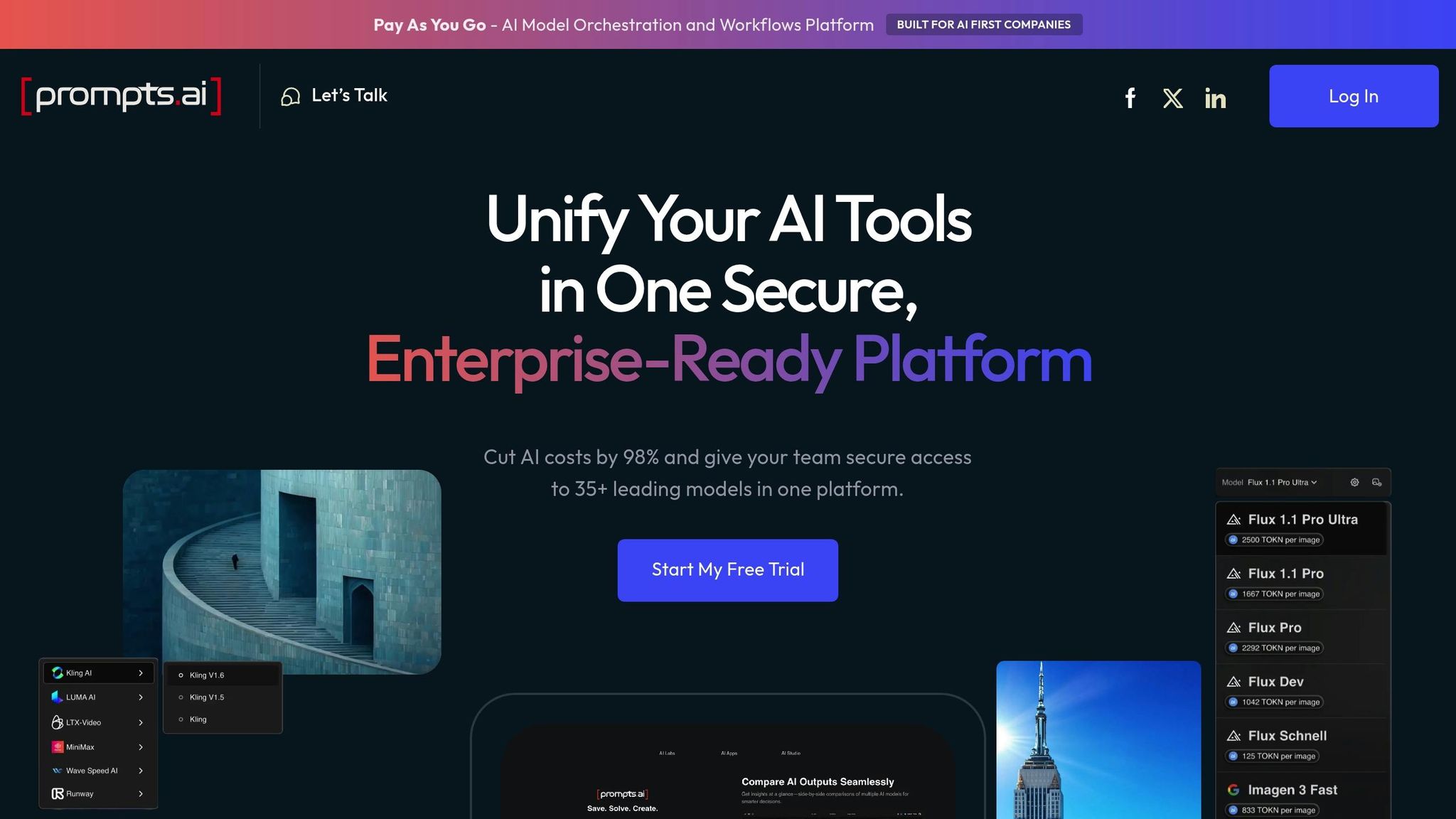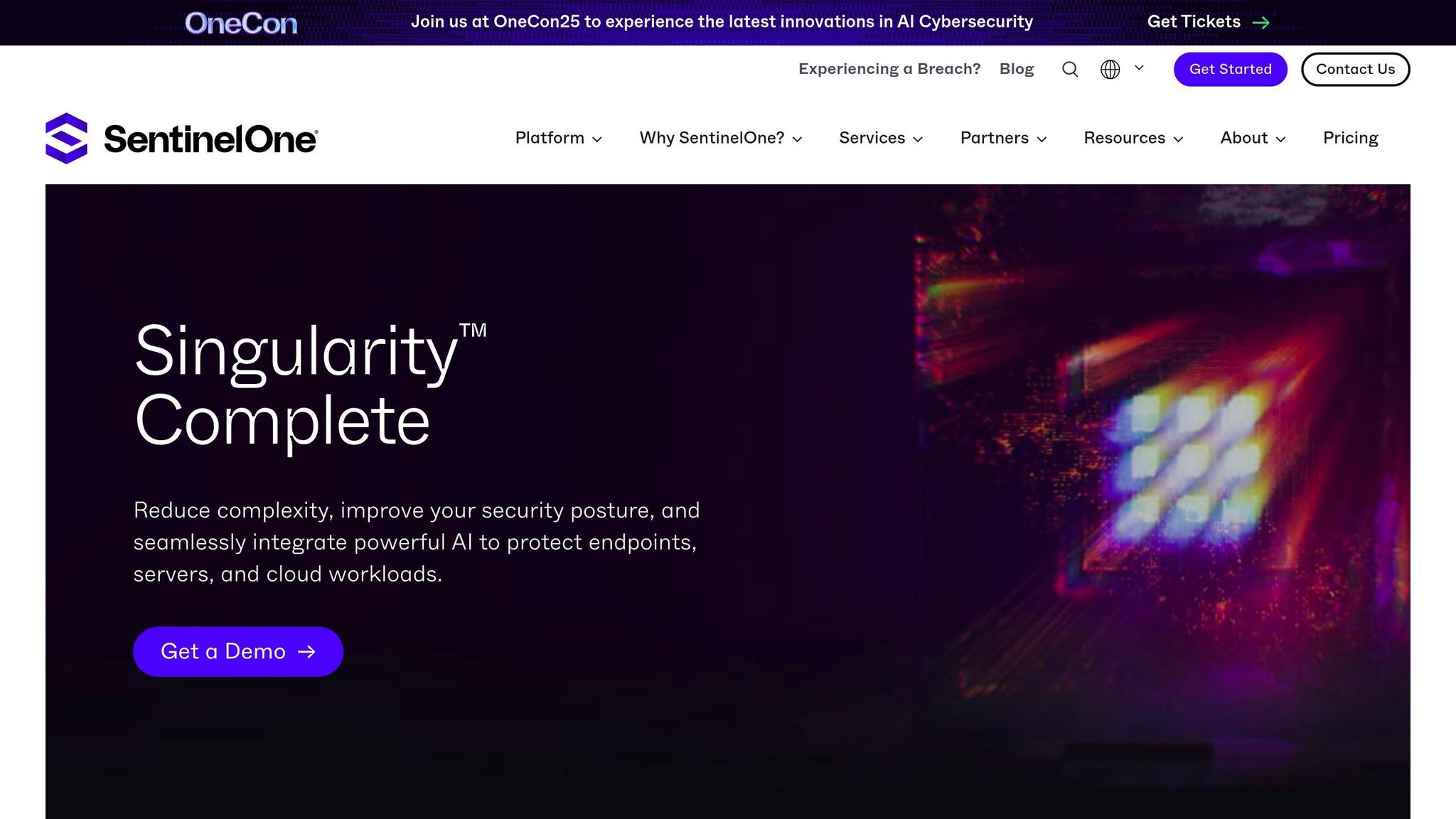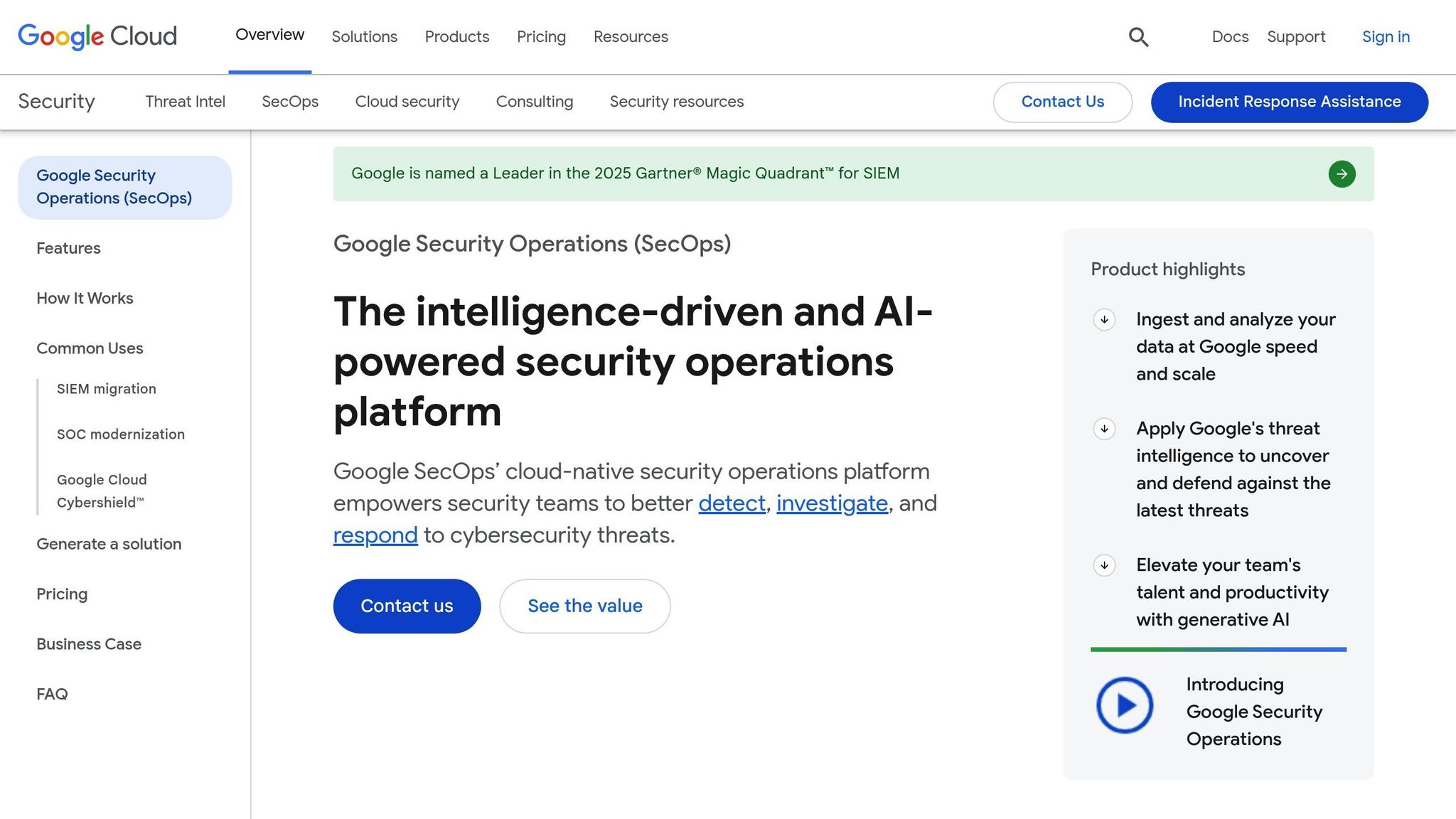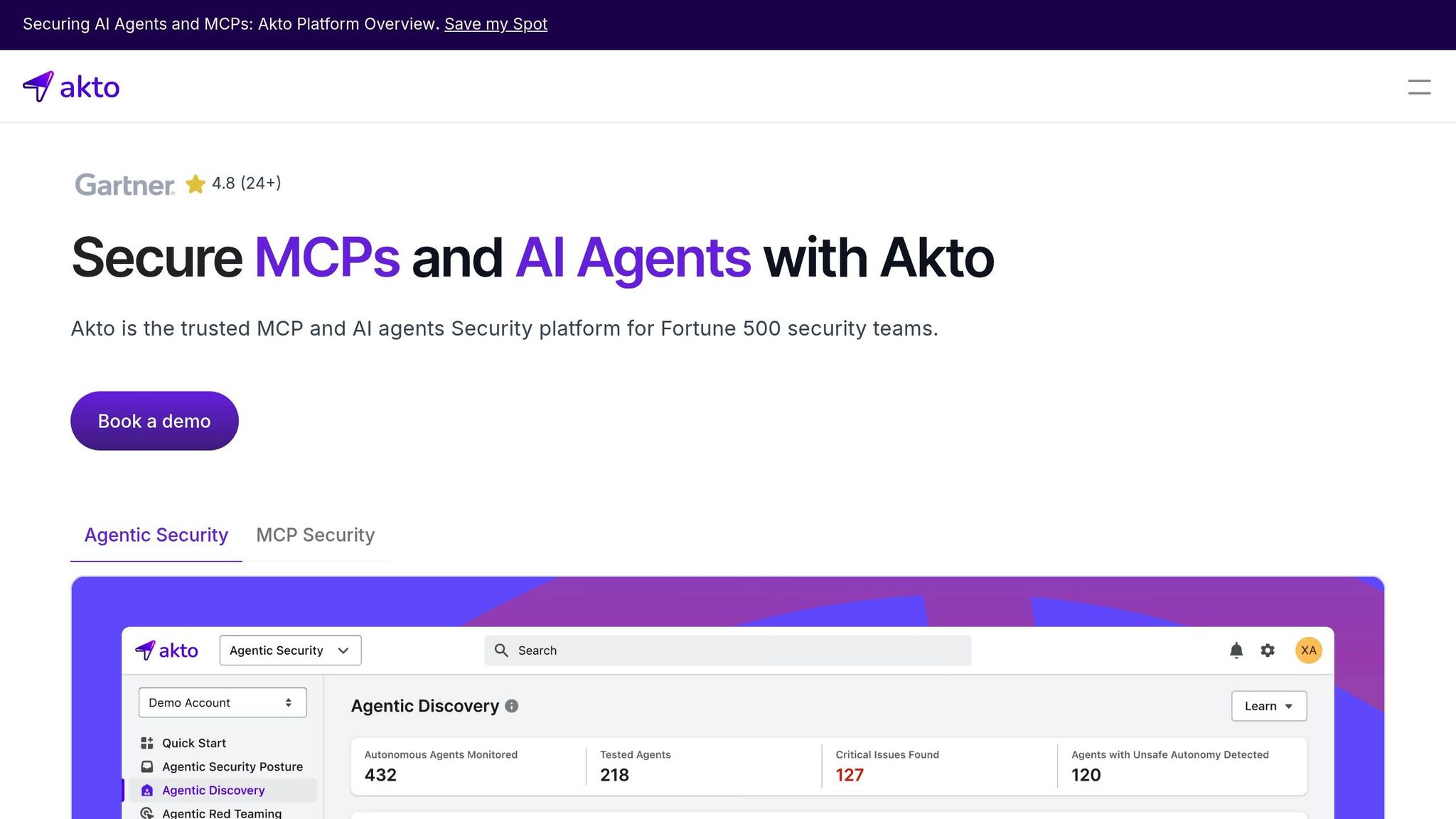
AI orchestration tools are transforming how enterprises manage workflows, but security risks from disconnected systems are growing. This article highlights seven platforms designed to centralize AI operations while prioritizing data protection, compliance, and access control.
| Tool | Strength | Limitation | Best Fit |
|---|---|---|---|
| Prompts.ai | Cost savings, model variety | Limited threat detection | Multi-model AI orchestration |
| SentinelOne Singularity | Endpoint security | Complexity, high licensing costs | Enterprise endpoint protection |
| Vectra AI | Network threat detection | Requires strong network visibility | Network-centric environments |
| Microsoft Security Copilot | Ecosystem integration | Vendor lock-in, learning curve | Microsoft-heavy infrastructures |
| Google SecOps | Global threat intelligence | Data residency concerns | Cloud-first organizations |
| Akto.io | API security | Narrow focus | API-heavy applications |
| Teleport | Zero-trust access control | Implementation complexity | Infrastructure access management |
Each tool addresses specific security challenges, from preventing data breaches to ensuring compliance. For cost-conscious teams managing multiple AI models, Prompts.ai stands out with up to 98% savings on AI software costs.

Prompts.ai is a security-focused platform built for enterprises, designed to streamline and secure AI operations. By integrating over 35 top-tier AI models - including GPT-5, Claude, LLaMA, and Gemini - into a single, cohesive system, it eliminates the risks and inefficiencies associated with fragmented AI tools.
Prompts.ai provides a unified framework that brings together models, tools, and teams, ensuring complete oversight and accountability for all AI activities. This approach reduces vulnerabilities caused by disjointed implementations. Business plans include centralized governance tools to maintain tight control over AI usage, keeping operations secure and compliant.
Adhering to industry-leading standards such as SOC 2 Type II, HIPAA, and GDPR, Prompts.ai prioritizes data protection. It employs continuous monitoring through Vanta, with a SOC 2 Type II audit scheduled for June 19, 2025. For real-time updates on its security measures, visit https://trust.prompts.ai/.
The platform supports flexible and scalable user management, enabling organizations to quickly onboard users and teams while maintaining secure collaboration. Subscription options range from pay-as-you-go individual workspaces to business plans with unlimited workspaces and collaborators. This structured approach to access control ensures that organizations can manage identities and permissions securely, complementing the platform's robust security architecture.
Prompts.ai is designed to navigate the complexities of regulatory requirements. Compliance monitoring is integrated into its Core, Pro, and Elite plans, reinforcing its commitment to enterprise-level security standards.
The platform seamlessly connects with widely used business tools like Slack, Gmail, and Trello. By enabling secure workflows across these systems, Prompts.ai ensures that its security measures extend throughout an organization’s entire tech ecosystem, providing consistent protection at every level.

SentinelOne Singularity is a cybersecurity platform designed to improve threat detection and response within AI workflows. While the platform's potential is clear, there is limited publicly available information about its data handling, access controls, identity management, and interoperability. This lack of detailed insights makes it challenging to fully assess its technical strengths and overall approach to threat mitigation. A deeper review is necessary to evaluate its capabilities and to effectively compare it with other tools in the market.

Vectra AI offers a cutting-edge network detection and response platform designed to identify and counter advanced cyber threats. By leveraging AI-driven behavioral analysis, it provides an essential layer of protection for complex AI workflows, complementing the security strategies discussed earlier.
Vectra AI's Attack Signal Intelligence technology continuously monitors network traffic and user behavior, using machine learning to establish behavioral norms. When deviations occur, it assigns prioritized threat scores, enabling swift action against potential risks.
The platform's automated threat hunting capabilities actively search for signs of compromise across hybrid and multi-cloud environments. It excels at detecting activities like lateral movement, data exfiltration attempts, and privilege escalation, all of which can target AI infrastructure.
To ensure security while minimizing risk, Vectra AI processes only network metadata and behavioral patterns, avoiding exposure to sensitive data payloads. All telemetry data is encrypted both in transit and at rest using AES-256 encryption standards.
The platform enforces data retention policies that automatically delete older security events based on configurable timelines. This feature not only helps manage storage costs but also ensures compliance with data protection regulations. For organizations with strict data residency needs, Vectra AI supports on-premises deployment.
Vectra AI integrates seamlessly with identity providers like Active Directory, LDAP, and SAML, employing role-based access controls and multi-factor authentication to secure user access. Its detailed audit logs capture timestamps, user identities, and actions, providing complete visibility into access activities.
The platform offers REST APIs and pre-built integrations with tools like SIEM platforms, security orchestration systems, and incident response solutions. With support for webhook notifications and custom integrations, Vectra AI ensures that threat intelligence and alerts integrate smoothly into existing security infrastructures.
Microsoft has combined the strengths of Security Copilot and Sentinel to create a robust, AI-powered security platform. This integration equips organizations with advanced tools for detecting and responding to threats, leveraging natural language processing and machine learning to safeguard AI workflows at an enterprise level.
Microsoft Security Copilot uses generative AI to enhance threat detection and analysis. By processing security signals across the Microsoft ecosystem with large language models, it identifies complex attack patterns that traditional systems might overlook. Security teams can interact with the platform through a natural language interface, simplifying the investigative process.
Microsoft Sentinel acts as the cloud-native SIEM backbone, capable of ingesting vast amounts of security data from hundreds of sources at petabyte scale. Its User and Entity Behavior Analytics (UEBA) feature establishes behavioral baselines for users, devices, and applications, flagging unusual activities that might signal compromised systems or data breaches. With machine learning algorithms that adapt to new threats, Sentinel ensures protection for evolving AI systems.
The platform’s integrated threat hunting capabilities blend human expertise with AI support. Security analysts can use Security Copilot’s natural language interface for incident investigations, while Sentinel’s Kusto Query Language (KQL) enables detailed forensic analysis across large datasets.
Microsoft employs zero-trust principles to ensure data security across its platform. Sentinel encrypts all data, both in transit and at rest, using AES-256 encryption, with keys managed through Azure Key Vault. For organizations requiring more control, customer-managed encryption keys (CMEK) are also supported.
Data residency controls allow organizations to specify where their data is stored, ensuring compliance with local regulations like GDPR. Sentinel further supports configurable data retention policies, enabling automated deletion of logs based on classification, age, or regulatory requirements.
For sensitive AI workloads, the platform provides data masking and tokenization to protect personally identifiable information (PII) during security analysis. These measures allow security teams to investigate threats without exposing sensitive training data or model details, reinforcing robust data access and protection protocols.
The platform integrates with Microsoft Entra ID (formerly Azure Active Directory) to deliver comprehensive identity and access management. Conditional Access policies enforce multi-factor authentication, device compliance, and location-based restrictions for accessing security tools and AI resources.
Role-Based Access Control (RBAC) ensures granular permission settings, with built-in security roles and the ability to create custom roles tailored to an organization’s governance framework. This helps align access levels with specific responsibilities, avoiding over-privileging.
Privileged Identity Management (PIM) adds an extra layer of security by enabling just-in-time access for sensitive operations. This feature is particularly useful in AI environments where temporary access to production models or training data may be required during incident response.
Microsoft Security Copilot and Sentinel are designed to meet the requirements of key compliance frameworks, including SOC 2, ISO 27001, NIST, HIPAA, and PCI DSS. The platform offers pre-built compliance workbooks that generate reports and dashboards to simplify regulatory audits.
Automated compliance monitoring continuously evaluates AI infrastructure against security baselines and regulatory standards. When deviations occur, the system can trigger remediation workflows or alert compliance teams. Detailed audit trails log all security activities, user actions, and system changes, supporting both forensic investigations and regulatory compliance.
Microsoft’s security platform is built for seamless integration with other tools and systems. Through REST APIs and the Microsoft Graph Security API, it connects with third-party security tools, AI development platforms, and custom applications. It also supports STIX/TAXII protocols for sharing threat intelligence with external security communities and government agencies.
Logic Apps integration enables automated response workflows across multiple systems. For instance, if Sentinel detects a potential AI model poisoning, it can isolate affected systems, notify stakeholders, and initiate incident response protocols.
The platform’s connector ecosystem includes over 300 pre-built integrations with security vendors, cloud providers, and enterprise applications. This ensures that Microsoft’s security tools can act as a central hub for managing complex, multi-vendor AI security architectures.

Google Security Operations (SecOps) taps into Google's extensive global infrastructure to deliver advanced security orchestration for AI workflows. Built to handle large-scale security telemetry, SecOps focuses on seamless data ingestion, processing, and protection, all while adhering to strict data governance requirements.
Google SecOps provides powerful tools for managing data pipelines, allowing users to route, filter, redact, and transform security telemetry at scale. With the Enterprise Plus package, users gain enhanced protection for sensitive AI training data and model parameters during security analysis. Notably, the platform includes one year of security telemetry retention at no extra charge, along with 12 months of BigQuery export storage at no cost.
To meet diverse customer needs and maintain data sovereignty, data processes are distributed across multiple global regions. Importantly, Google enforces a clear policy that excludes user history and Gemini conversation data from model training, ensuring the confidentiality of security investigations. These practices establish a strong foundation for meeting rigorous regulatory standards.
SecOps is designed to comply with major industry standards, such as SOC 2, ISO 27001, GDPR, and HIPAA. Through its robust data governance measures, the platform ensures that AI training data and model outputs meet regulatory requirements during security analysis.
SecOps integrates seamlessly with BigQuery, enabling users to perform advanced analytics and create custom reports for security metrics. This integration supports long-term forensic analysis, empowering security teams to uncover insights tailored to their AI workflows.

Akto.io is designed to safeguard AI agents and Multi-Cloud Platforms (MCPs) from targeted cyberattacks. With cybersecurity risks topping the list of concerns for enterprises deploying AI agents in production, Akto.io provides a tailored security framework to meet the demands of modern AI workflows.
Akto.io focuses on discovery and continuous vulnerability testing, ensuring comprehensive protection. The platform automatically maps AI agents, MCPs, tools, and resources across an organization’s infrastructure, cloud, and endpoints. This capability addresses a critical need, as 9 out of 10 security leaders identify MCP/agent discovery as essential. Akto.io enhances security through:
Additionally, Akto.io employs automated red teaming and posture management to continuously test for vulnerabilities, bolstering an organization's defenses against evolving threats.
Akto.io prioritizes safeguarding sensitive data during runtime operations. It enforces scalable guardrails to block unauthorized actions while providing integrated testing capabilities that deliver 100x better coverage of agentic actions. This enables organizations to swiftly pinpoint and address potential data exposure risks.
"I use Akto for API inventory and the customizations available, friendly interface, excellent support, monitoring sensitive data."
Akto.io’s credibility is backed by recognition in Gartner’s Techscape for Startups in Cloud and Application Security and its listing as a Representative Vendor in Gartner's 2024 Market Guide for API Protection. These accolades underscore its reliability in securing AI workflows. With an overall rating of 4.8 out of 5, Akto.io is also featured in Top API Security Solutions Reviews.
Built with an API-first design, Akto.io integrates seamlessly into existing development workflows. Its automated security testing scales effortlessly across diverse environments, having analyzed and secured over 1 million agent–tool actions. Customers have highlighted its ease of use and effectiveness:
"Very easy to deploy Akto tool, not much configuration needed. Integrate the same into CICD, everything is done at one place."
Another customer from the banking sector shared:
"Akto has helped us largely in security testing and API cataloging, we have been able to perform automated security testing at scale."
These robust integration capabilities make Akto.io a standout solution in the competitive field of secure AI orchestration.
Teleport provides secure, zero-trust access to servers, databases, applications, and Kubernetes clusters, ensuring the protection of sensitive operations in AI workflows.
Teleport employs certificate-based authentication, issuing short-lived certificates for access requests. This approach minimizes reliance on static credentials and significantly reduces potential attack surfaces. Additionally, it records all sessions, creating detailed audit trails for ongoing monitoring and accountability.
Teleport's role-based access control (RBAC) integrates effortlessly with widely used identity providers like Active Directory, SAML, and OIDC. It also supports just-in-time access provisioning, allowing teams to grant temporary elevated permissions when necessary, without maintaining high-privilege accounts on a continuous basis.
Sensitive data is safeguarded through encrypted audit logs and mutual TLS encryption for all communications between Teleport components. Its secure database access feature ensures safe connections to data stores, while dedicated application access protects critical interfaces from direct exposure to the internet.
Teleport’s detailed audit trails help organizations meet compliance standards such as SOC 2. Recorded session data provides robust support for regulatory oversight, demonstrating adherence to security best practices and ensuring transparency.
Teleport's security measures integrate smoothly into modern IT environments. Its Terraform provider supports infrastructure-as-code workflows, enabling automated provisioning of access policies. Kubernetes integration ensures containerized workloads are secured, while an API-first design allows for easy integration with existing security tools and monitoring systems. This ensures that access management becomes a natural part of broader security strategies.
This section provides a concise comparison of tools, focusing on their strengths and limitations in areas such as cost management, threat detection, and integration. By examining these trade-offs, organizations can better align their choices with specific security priorities.
Prompts.ai shines in reducing costs and offering a wide range of AI models, with access to over 35 leading language models through a single interface. It boasts real-time FinOps controls for clear spending visibility and enterprise-grade governance to maintain compliance. However, its emphasis on orchestration over deep security analytics may not meet the needs of organizations requiring advanced threat detection.
SentinelOne Singularity excels in endpoint protection, leveraging behavioral analysis to detect zero-day threats in real time. Its autonomous response capabilities can contain threats within seconds, and its cloud-native architecture scales effectively across enterprises. On the downside, its complexity may require dedicated expertise, and higher licensing costs might be a hurdle for smaller organizations.
Vectra AI focuses on network-based threat detection, using machine learning to identify lateral movements and insider threats. With low false-positive rates and detailed behavioral analytics, it reduces alert fatigue and provides valuable network insights. However, its performance depends on strong network visibility, which can be a challenge in highly distributed or cloud-first setups.
Microsoft Security Copilot & Sentinel integrates seamlessly within the Microsoft ecosystem, offering natural language querying to simplify security operations. Its cloud-native SIEM efficiently handles large data volumes, and built-in compliance frameworks ease regulatory challenges. Still, organizations not already embedded in Microsoft's ecosystem may face vendor lock-in and a steep learning curve.
Google Security Operations (SecOps) benefits from global threat intelligence, drawing on billions of security events to enhance detection accuracy. However, data residency requirements can limit its appeal in certain regions, and integration may be complex for non-Google-centric environments.
Akto.io specializes in API security, automating vulnerability detection across REST, GraphQL, and WebSocket APIs. Its developer-friendly design integrates well into CI/CD pipelines, offering real-time monitoring for ongoing protection. That said, its narrow focus on API security may require additional tools for broader security needs.
Teleport emphasizes zero-trust access control, using certificate-based authentication to reduce risks tied to static credentials. It supports automated policy management and session recording, though its implementation can be challenging in legacy systems, and the learning curve may slow early adoption.
| Tool | Primary Strength | Key Limitation | Best Fit |
|---|---|---|---|
| Prompts.ai | Cost efficiency and model variety | Limited specialized threat detection | Multi-model AI orchestration |
| SentinelOne Singularity | Autonomous threat response | Operational complexity & licensing costs | Enterprise endpoint protection |
| Vectra AI | Network behavioral analysis | Dependency on network visibility | Network-centric environments |
| Microsoft Security Copilot & Sentinel | Ecosystem integration | Vendor lock-in & steep learning curve | Microsoft-heavy infrastructures |
| Google Security Operations (SecOps) | Global threat intelligence | Data residency concerns | Cloud-first organizations |
| Akto.io | API security specialization | Narrow security focus | API-heavy applications |
| Teleport | Zero-trust access control | Implementation complexity | Infrastructure access management |
This overview highlights the unique strengths of each tool, helping organizations weigh their options based on priorities like cost savings, advanced threat detection, integration needs, or API security.
Choosing the ideal AI orchestration tool means weighing factors like security, compliance, and operational performance. Each solution brings distinct advantages, and matching these to your organization's goals is essential.
For teams focused on cutting costs while maintaining secure oversight, Prompts.ai stands out. It provides seamless access to leading AI models alongside real-time FinOps controls, enabling up to 98% savings on AI software costs. At the same time, it ensures compliance and full auditability, reflecting the growing shift toward more secure and efficient AI workflows.
AI orchestration tools strengthen security by implementing robust measures to protect sensitive data and maintain compliance throughout workflows. Key features such as role-based access controls, encryption, and adherence to established industry security standards work together to safeguard information effectively.
These tools also improve oversight and clarity by providing detailed insights into AI decision-making processes, fostering accountability and trust. By automating security protocols and ensuring consistent application of policies, they make it easier to manage multiple AI models while effectively reducing potential risks.
Prompts.ai aligns with critical compliance standards such as GDPR, HIPAA, and ISO/IEC 27001, prioritizing data security, privacy, and adherence to regulatory requirements. These frameworks are designed to protect sensitive data, implement strong access controls, and build confidence in AI-powered workflows by meeting stringent legal and industry guidelines.
Staying compliant with these standards is essential for protecting your data, minimizing legal exposure, and seamlessly embedding security into your AI operations. By adhering to these protocols, Prompts.ai ensures businesses can fulfill their security responsibilities while managing AI workflows efficiently and securely.
AI orchestration tools bring a dual advantage to businesses: saving money and bolstering data security. By automating routine tasks and simplifying workflows, they allow teams to dedicate their time to more strategic projects. These tools also manage computing resources across hybrid or multi-cloud setups, ensuring resources are used efficiently and cutting down on wasteful spending.
On the security front, these platforms come equipped with powerful features such as role-based access controls, data encryption, and adherence to industry standards. These measures protect sensitive data and ensure regulatory compliance, offering businesses confidence in securely managing their AI-driven operations.


